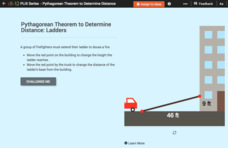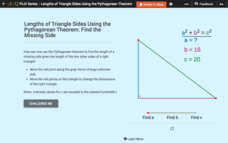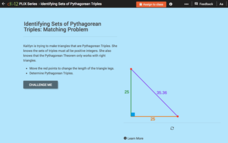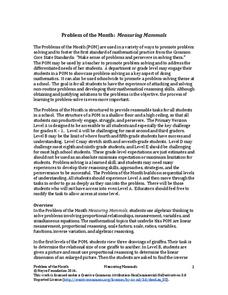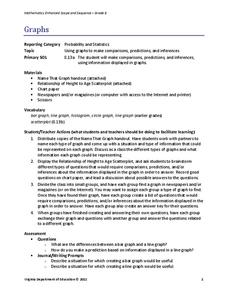CK-12 Foundation
Factoring by Grouping: Polynomials
Investigate the process of factoring polynomials by grouping. A detailed lesson initially has learners follow a set-by-step example. They then drag terms to complete the three steps of a new problem.
CK-12 Foundation
Using Quadratic Equations to Solve Problems: Construct a Soccer Field
Build a soccer field through a little mathematical analysis. Individuals manipulate the dimensions of a soccer field as they drag points to new positions. The simulation shows the corresponding intercepts and area. As pupils explore the...
CK-12 Foundation
Solving Problems by Factoring: Building a Doghouse
Building a doghouse is easier with a little mathematical help! Young scholars use sliders to adjust the length of the doghouse and watch as it affects the width and area. They then answer questions that help them discover the question...
CK-12 Foundation
Negative Exponents
Watch the exponent expression do the negative exponent dance! An interactive lesson uses an animation to show how negative exponents become positive. Learners manipulate the expression and then respond to conceptual questions.
CK-12 Foundation
Pythagorean Theorem to Determine Distance: Tree Shadows
Why is that shadow getting longer? Determine the changes in the length of a shadow as the sun changes position in the sky. Individuals use an interactive to calculate the length of a shadow at different times during the day via the...
CK-12 Foundation
Pythagorean Theorem to Determine Distance: Ladders
Young mathematicians to the rescue! Pupils use an interactive to find lengths relating a ladder against a building. The problems involve determining how long a ladder must be to reach a given floor to what floor can a given ladder reach.
CK-12 Foundation
Pythagorean Theorem to Classify Triangles: Missing Angles
Learn to use the Pythagorean Theorem with non-right triangles. Pupils use the interactive to discover the relationship between the lengths of sides for acute and obtuse triangles. They compare the squares of the sides of the triangles to...
CK-12 Foundation
Identifying Sets of Pythagorean Triples: The iPad is a Pythagorean Triple
Compare iPad and HDTV aspect ratios. Individuals use the interactive to determine whether the measurements of screens represent a Pythagorean triple. The pupils determine what changes are needed to make a Pythagorean triple.
CK-12 Foundation
Lengths of Triangle Sides Using the Pythagorean Theorem: Find the Missing Side
What is the relationship between the sides of a right triangle? Learners use an interactive to create models of right triangles and view the relationship between the lengths of the sides. They finish by using the Pythagorean Theorem to...
CK-12 Foundation
Identifying Sets of Pythagorean Triples: Matching Problem
What sets of whole numbers make up the measures of side lengths in right triangles? Pupils use an interactive triangle to learn about Pythagorean triples. Individuals find missing values in triples and learn more about Pythagorean...
CK-12 Foundation
Exponent Properties with Variable Expressions: Size of Solar Tornadoes
Exponents may have your pupils' heads spinning after an engaging lesson as they connect properties to tornadoes! Learners compare a distance between cities to the distance across a solar tornado. They use exponent properties to find the...
CK-12 Foundation
Exponent Properties with Variable Expressions: Integer Powers
Exponent properties can be complicated for learners. A creative lesson seeks to simplify the concept and build a solid understanding. Young mathematicians have the opportunity to create numerous expressions and analyze the simplified...
CK-12 Foundation
Scientific Notation: Light Years to Centaurus Constellation
Connect scientific notation to a real-life situation. Measuring distances in our solar system require large numbers. As pupils make conversions using these large numbers, they begin to see the necessity of scientific notation. They...
CK-12 Foundation
Scientific Notation: Matching Numbers to Notation
Explore the conversion of numbers to scientific notation and back again. Learners begin with a matching activity to identify equivalent expressions. Then guiding questions test and extend their understanding.
Noyce Foundation
Measuring Mammals
Explore the meaning of scale and proportion with a set of five activities that examines the topic from elementary through high school. The first lessons explore ratio by examining pictures of different sizes. The next three activities...
Noyce Foundation
Digging Dinosaurs
Build a function to solve problems rooted in archeology. A comprehensive set of five lessons presents problems requiring individuals to use functions. The initial lesson asks learners to find the possible number of dinosaurs from a...
Noyce Foundation
Between the Lines
Explore linear and square dimensions by comparing areas of similar figures. A creative set of five activities designed for elementary through high school classes asks young scholars to compare areas of specific polygons. The first two...
Virginia Department of Education
Pythagorean Theorem
Investigate the meaning of the Pythagorean Theorem through modeling. After comparing the area of the square of each side, individuals cut triangles and squares to facilitate the comparison.
Virginia Department of Education
Transformations
Geometry in life-sized dimensions! Using enlarged graph paper, pupils perform a series of transformations. By recording the initial and final placement of the images, they are able to analyze the patterns in the coordinates during a...
Virginia Department of Education
Graphs
Examine different types of graphs as a means for analyzing data. Math scholars identify the type of graph from a series of data displays and then develop questions to match each one. Then, given a scatter plot of height versus age...
Virginia Department of Education
Independent and Dependent Variables
Investigate the relationship between independent and dependent variables. Individuals begin by identifying independent and dependent variables from different problem situations. Then, using specific guidelines, they create posters...
Teach Engineering
New Perspectives: Two-Axis Rotation
Two-axis rotations ... twice the fun as one-axis rotations! The last installment of a five-part module teaches scholars how to conduct two-axis rotations. They create isometric drawings before and after the rotations.
Teach Engineering
Let's Take a Spin: One-Axis Rotation
Investigate the effect of one-axis rotations on geometric figures. Scholars learn to use snap cubes and the right-hand rule to draw figures after rotations about the x-, y-, or z-axes. They try their hands at examples created by the...
Teach Engineering
Seeing All Sides: Orthographic Drawing
How can your draw three-dimensional figures on paper? The lesson shows pupils how to draw orthographic projections of three-dimensional figures composed of cubes. After viewing a PowerPoint presentation, they practice this skill with...





